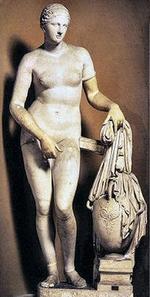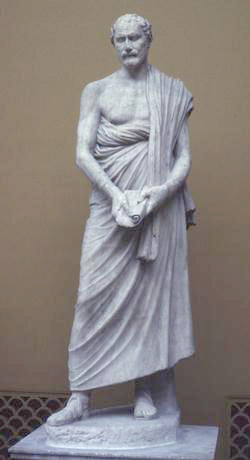Art after Empire, cont.
Also famous among the works of Praxiteles--perhaps most famous-- was his Aphrodite of Knidos.
[click on Thumbnail for another copy]

The statue was set in a round enclosure such that the observer, from any angle, had the impression of surprising the goddess naked in the bath. The appeal has been described as "frankly, although not vulgarly, erotic"--even the birth of pornography. Be that as it may, the obvious approach portraying the goddess's beauty as a stolen intimacy, perhaps suggests something about the changed temperament of sculpture in the century after the Athenian experiment: turning away from the monument to communal worship toward more personal experience. This Aphrodite became the model for most of the popular renditions of later antiquity, including the Venus de Milo (=of Melos)
Striking in this regard is the changed treatment of standard warlike characters in the pedimental sculptures on the Temple of Asclepius at Epidaurus, ca. 380. The subject once again is the (2nd) Trojan War, but the suffering of the defeated takes on new depth of pathos.
Compare the Fallen Warrior at Epidaurus
withthe Dying Warriors on Aphaia's Temple on Aegina (ca. 490-80):
West Pediment (=2nd Trojan War) and East Pediment (1st Trojan War but later art).
Also indicative from the pediments at Epidaurus is th severed head of Priam, held by the hand of Neoptolemus. Note the contortion of the face, the hollowed eyes, portraying pathos.
Finally, in the later fourth century, this sensationalizing style led to change in standard proportion,, a lengthening of the human form and diminishing the face, pioneered by Lysippus.This change in proportion (symmetria) was meant to reflect the apparent rather than actual dimensions.
The style is given radical expression in the gaunt Demosthenes of Polyeuctus.
